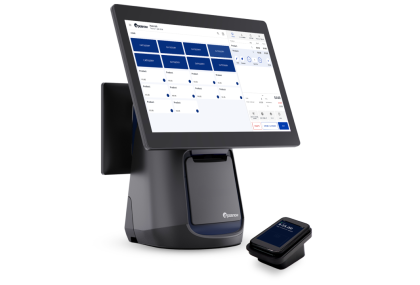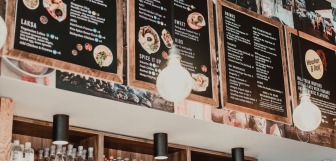Menu Planning: Everything You Need To Know
As a hospitality business owner, creating a menu plan can be daunting. You need to think about the meals you want to serve and how they will fit into your menu. Additionally, menu planning involves making decisions on pricing and portion sizes that can be difficult.
But don't fret. Because in our complete guide to menu planning, we'll guide you through each step of the menu planning process so that you can create a menu that is both delicious and successful. By the end of this guide, you'll know the following:
- What menu planning is and why it's important
- The basics of creating a menu plan
- How to determine pricing and portion sizes in your menu plan
- How to create a menu plan that meets customer demand
- Tips for menu success
Let's get started.
What is menu planning?
Menu planning is creating a menu for your restaurant or food business. It involves a lot of research and study to determine what meals are popular in your area and how much you should charge for them.
Menu planning begins with your restaurant's concept. What type of restaurant/hospitality business do you want to open? Will it be a casual eatery, fast-food restaurant, or something more upscale? What cuisine will you serve?
What is meal planning?
Meal planning is deciding what meals you will serve, how much they will cost, and their portion sizes. You should also consider menu options that appeal to various customers when grocery shopping, such as health-conscious or vegan diners.
The meal planning process can be time-consuming, but it's worth it for the success of your menu and can even help you save time in the future. To make the process easier, create menu items in bulk so you can prepare several meals at once, as well as menu templates that you can use for future menu planning.
Menu planning vs. meal planning
Menu planning and meal planning are often confused, but they are quite different. Planning a menu involves creating the menu itself, while meal planning focuses on creating the meals that will be served. Planning a meal includes decisions on pricing and portion size, as well as menu items or recipes that appeal to various customers.
Types of menus:
The type of menu you choose for your restaurant depends on the type of restaurant you are running. Here is a quick overview of the types of menus available:
- Cycle menus: These types of menus involve creating a menu that changes over time. This type of menu can benefit restaurants as it allows them to serve new and exciting dishes regularly, encouraging customers to continue returning. When planning out your shopping list for these menus, be sure to plan for a three-week cycle and to always have backup ingredients in case you run out of something.
- Daily specials: Daily specials are one-off dishes that are created daily. These menus allow you to use seasonal ingredients and innovate in the kitchen without committing to long-term menu planning. Remember, when creating grocery shopping lists, it's important to plan for seasonal ingredients.
- Fixed / static menus: Fixed menus are a great option for restaurants that want to keep their menu consistent over a long period of time. This type of menu is beneficial as it allows customers to become familiar with the dishes they can expect while giving you more control over pricing and portion sizes. When creating a shopping list for grocery shopping, it's important to find the best sources of supply at the best prices.
Benefits of menu planning
1: Improved profitability
By menu planning, you can ensure that your menu is profitable by adjusting menu prices and portion sizes to maximize profits.
For example, suppose you want to open up a Thai restaurant in New York. In this case, you could research your competitors as a part of your menu planning process. Doing this will help you to determine things like:
- What they're pricing menu items
- How big their portions are
- What menu items customers are frequently ordering
- How many meals they have on their menu
If you find that your competitors are pricing their meals at a much higher rate than you are, you may want to adjust your menu prices accordingly. This could increase your profits and make your menu items more competitive.
Alternatively, if you find that your competitors are a lot more affordable than you, you may need to consider reducing your menu prices so that customers don't go elsewhere. By menu planning, you can also determine which menu items are the most profitable and focus on selling them more often. This is a great way of ensuring that your menu is as profitable as possible and can help save money.
2: Menu planning/meal planning allows for more creative menu items
By menu planning, you can create menu items that are creative, delicious, and interesting. That's because menu planning allows you to spend time brainstorming and researching menu ideas and finding recipes. You can also experiment with flavors and ingredients to create unique menu items that will stand out from the competition.
For example, if you own a food truck that sells Mexican cuisine. You know you want to be unique and stand out from the competition. During menu planning, you could research traditional Mexican dishes and find recipes with seasonal ingredients or other cuisines that would work well as a fusion menu item. This could lead to menu items like a seasonal taco with a unique twist or a Mexican-Japanese fusion dish.
By menu planning, you can create menu items that are creative and unique, which will help your restaurant/hospitality business stand out from the competition.
3: Menu planning helps you to understand customer demand
By menu planning, you can gain a better understanding of what your customers want. For example, menu planning involves researching menu items that are popular in your area. This will help you determine the type of food that customers prefer and allow you to create menu items accordingly.
You can also gain insights into menu items that are underperforming. By menu planning and understanding customer demand, you can make adjustments to your menu to ensure that customers have more choices.
TIP: Using POS technology can help you to gain better insights into your customer's menu preferences. This will allow you to menu plan meals more effectively, as you'll have access to data on menu items that customers are ordering and menu items that they're not.

The Complete Hospitality POS System
On-site dining, takeaway, or delivery? You choose. Adapt and thrive with a POS system that makes it all possible.
Considerations for the menu planner
Before menu planning, there are a few things to consider. These include:
Budget and menu prices
Before menu planning, it's important to know your budget and menu prices. This will help you determine menu items that fit within your budget and competitive prices in your area. It will also help you save money.
For example, suppose you only have a small budget for food costs. In this case, menu planning could involve looking at cheaper ingredients that can still create delicious menu items. Or, it can help you decide on a restaurant concept that doesn't require expensive menu items.
TIP: Check out our menu pricing strategy blogs for more tips.
Menu length
Believe it or not, menu length can impact your profits. A menu that's too long can be overwhelming for customers, while a menu that's too short may not offer enough variety.
When menu planning, you should consider how many menu items are necessary. Consider menu items that are popular in your area and menu items that you would like to feature on the menu. This will help you create a menu with enough variety without being too overwhelming for customers.
Tips for deciding how long your menu should be:
- Consider customer feedback
- Research popular menu items in your area
- Consider seasonal ingredients and special dishes
Delivery and takeout menu planning
If you're offering delivery and takeout services, menu items will need to be tailored accordingly. This is because menu items that may work well in a dine-in setting may not work well for delivery or takeout.
For example, suppose you're offering your customers a dessert with fresh ice cream. In that case, you'll need to consider the packaging you can use to deliver this without it melting or the radius and distance you can deliver this menu item.
TIP: Want to connect with more customers on leading food delivery platforms? Epos Now Delivery seamlessly integrates with your POS system and expands your customer reach by promoting your restaurant on the market's most popular food ordering channels.
Names and descriptions
What's in a name? A lot when it comes to menu items. When menu planning, you'll want to think about menu item names and descriptions that give customers an accurate idea of what they're ordering.
This may require menu research to find interesting menu item names and engaging descriptions. It can also involve menu testing to ensure menu items have the right description.
Some tips for writing brilliant menu descriptions include:
- Concentrate on menu ingredients
- Make menu descriptions mouth water
- Use menu descriptions to story tell
- Showcase menu items with visuals
TIP: Getting the menu right is one of the most important parts of running a restaurant. Check out our restaurant menu items list blog post for menu item inspiration.
Balanced meals
Unless you're opening up a steak restaurant, menu planning should include a balance of menu items. This includes meals with different proteins (meat, fish, vegetarian), carbohydrates, and vegetables.
This will ensure that customers have enough menu options and provide them with balanced meal options. It can also help you make sure menu items are prepared with the right cooking techniques, such as steaming, baking, or frying.
For example, if you're opening an Italian restaurant, you may want to offer 4-5 main dishes with different meat, such as chicken, lamb, and beef. You'll also need to have some vegetarian and vegan options and some seafood options. Pair these main dishes with various side options such as bread and salads.
Menu design and layout
Once you have your menu items and descriptions, the next step is to design the menu layout. The goal here is to ensure customers can easily navigate the menu and find what they're looking for.
Consider how many pages the menu will be, where each section will be located (starters, mains, desserts), and how items are organized within each section. You can also add visuals to the menu, such as a logo, iconography, and photos of dishes.
Some more tips for designing the perfect menu layout:
- Keep your menu organized with clear categorization
- Use fonts and colors that fit your brand style
- Make sure typeface is easily readable
- Include icons to highlight special dishes, such as vegan, gluten-free, and nut-free options
- Ensure pricing is clearly visible and consistent
How to develop a profitable menu
The goal of menu planning is to develop a menu that appeals to your customers, provides them with delicious and balanced meals, and is profitable for you.
Here are ten menu planning tips to help you create a menu that meets all these needs:
Research food trends and menu items
Throughout time menu items come and go, so menu planning should involve researching menu item trends before you create your grocery list. This could include researching menu trends in your area, looking at menu items from other restaurants in the area, or researching food trends online.
Some trends to consider include menu items that are:
- Healthy and or sustainable: Health and wellness are becoming more important to customers, so menu items that are healthier choices, including nutritious meals that are sustainably sourced.
- Unique and creative menu items: Customers love menu items that are unique and creative. If you have menu items that no other restaurant offers, this can be a great way to attract customers.
- Instagrammable / photo-worthy menu items: Customers often take photos of menu items for Instagram or other social media accounts. So menu planning should include menu items that are visually appealing and photo-worthy
Decide what type of menu you want to offer
When menu planning, you'll need to decide the type of menu you want to offer. This could include a full menu with all meal types (breakfast, lunch, and dinner) or just a few menu items for each meal type. You may also want to focus on one particular style of cuisine.
Here are some popular cuisine types to consider:
- American
- French
- Italian
- Mexican
- Japanese
- Thai
- Vegetarian/ vegan
Calculate menu pricing and menu costing
Menu pricing is one of the most important parts of menu planning, as menu items need to be priced correctly to ensure profitability for your restaurant. Menu costing is a way to calculate menu item prices by looking at the cost of available ingredients, overhead costs, and labor costs associated with menu items.
Plan menu item descriptions
Writing menu item descriptions can be tricky, as you must find the perfect balance between creative menu writing and menu accuracy. This can involve menu descriptions that draw in customers and menu descriptions that accurately describe menu items.
Hiring a professional copywriter or menu planner can be helpful in menu planning, as they will be able to provide menu descriptions that are both creative and accurate.
Review menu items regularly
Menu items should not be set in stone, so it's important to review menu items regularly. This can involve adding new menu items to your grocery list that align with customer needs, changing menu item descriptions as necessary, or removing menu items altogether to make room for new menu items.
Take advantage of seasonal ingredients
Seasonal ingredients are a great way to provide customers with unique menu items and also save money on menu items. Menu planning should involve adding seasonal ingredients to your grocery list wherever possible to ensure menu items are fresh and cost-effective.
Create menu item bundles
Bundles can be a great way to boost sales, as customers can get more food for their money. Offering menu item bundles such as meal deals or family meals can encourage customers to buy the food they wouldn't normally order.
TIP: A restaurant POS system can help you easily and quickly create menu item bundles.
Consider menu presentation
Presentation is everything, so menu planning should include menu presentation considerations such as plate ware, plating techniques, and menu item placement. This can help menu items to stand out on the menu, draw attention to dishes and make menu items more appetizing.
Some menu design tips include:
- Using visuals such as photos or illustrations of food
- Showcasing customer favorites by placing them at the top of the menu
- Placing pricier items lower on the menu to draw attention away from them
- Placing vegetarian, vegan, and gluten-free options close together to make it easier for customers to identify them
- Using eye-catching fonts and colors to draw attention to food items
Analyze menu performance
Menu items should be reviewed regularly to ensure they're profitable and menu sales are maximized. Menu analysis can include looking at menu item sales, menu item performance, and menu item profitability. This data can then adjust menu items accordingly for optimal menu performance.
How can a POS system help with menu planning?
A POS system can be a great tool for menu planning, as it can provide menu analytics and reports that will help you analyze menu item performance.
A Hospitality or retail POS system comes with several features, such as menu item tracking, menu item bundling, and menu item descriptions which can help you to streamline menu planning processes. Additionally, a POS system can provide menu analytics such as menu sales and performance reports, which can help you analyze menu items and adjust menu items accordingly.
Some POS systems also have their own payment processing services, so menu payments can be processed quickly and easily. This streamlines menu planning processes and helps to ensure menu items are served in a timely manner.
Food waste tracking is also essential, as it helps reduce wasted food and improve profitability. An efficient point of sale for the hospitality industry system can track food waste from start to finish and provide data on areas where food waste could be reduced. This can help to ensure that your dishes are profitable and menu sales are maximized.
Final thoughts
So there you have it. Our complete guide on menu planning: Everything You Need To Know. Menu planning is an essential part of running a successful restaurant, so menu planning should be taken seriously, and menu items should be reviewed regularly to ensure menu items are profitable and menu sales are maximized.
Using a POS system can help to streamline menu planning processes and provide menu analytics which will help you to analyze menu item performance and adjust menu items accordingly.
We hope you found this guide helpful, and we wish you the best of luck with menu planning!
Want to know more about our restaurant POS system? Contact our team of experts today!




